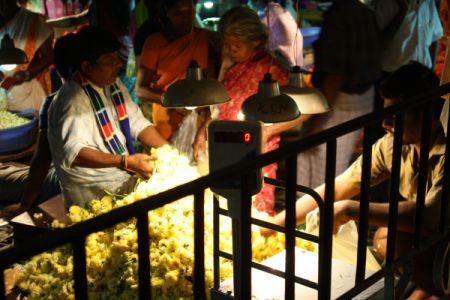by Rachel Bessonny & Katherine Arnold, Juniors in Supply Chain Management, University of Illinois at Urbana-Champaign.
The following post was written by students on an ADM Institute-sponsored observation study tour through India.

A vendor weighs and sells flowers at wholesale Koyambedu Market, Chennai, India Credit: ADM Institute/Kari Wozniak
The first day activities on the itinerary of our trip to study agricultural supply chains in India seemed somewhat unrelated. Our first stop, a temple, second, a local non-governmental organization, and third, a fruit and vegetable market. Little did we know, however, a small detail would ultimately be an important link between the observations and conversations we had along the way.
At a local temple near our hotel in Chennai, we got a brief view of Hindu culture. One of the first things we noticed, besides the hustle and bustle on the street, was a sweet floral scent. There were vendors lining the street selling their wares—different variations of a simple garland and strands of colorful flowers everywhere. In the temple we saw many people holding flowers in their hands, which they then would place as an offering near different statues of popular deities. At one shrine, priests gifted garlands of flowers to our chaperones, a special token to wish our group a safe and successful trip.
Our next stop was a local NGO called the MarketPlace Literacy Community Trust (MLC). The organization, which works to educate smallholder farmers about basic financial literacy and marketing techniques, was founded in 2003 by University of Illinois at Urbana-Champaign Professor Madhu Viswanathan. There we interviewed rural farmers about their lives and agricultural practices. One of the interviewees who stood out the most was an older woman who raised her 4 sisters and 1 brother on the salary from her small farm. She currently grows rice, chili peppers, and flowers, with the most profitable being the flowers. Recently, she told us, she has been able to market her crops for better prices. This success is in large part due to the education she received from the MLC Trust.
After interviewing several local farmers, we visited the Koyambedu Market, the largest wholesale market of fruits, vegetables, and flowers in all of Asia. While interviewing a flower seller, we were amazed to learn that even though the piles of colorful roses appeared very large to us, all of the product is indeed sold by the end of the day. According to the sellers, there is no waste. But as we learned through conversations with them, they will often reduce their price as the day goes on to sell all of their flowers. This greatly lowers their profit margin, resulting in profit loss of their product.
We finished our day with a view of the scenic Marina Beach on the coast of the Bay of Bengal. When we noticed a man riding his bicycle with a basket of roses, we realized the significance of what linked the whole day together – the flowers. The ones we had admired early in the day were grown by a farmer like the woman we interviewed at the MLC. They likely then came to the Koyambedu Market where they were sold to a pushcart vendor who sells outside of temples like the one we visited. Finally, those flowers made it into the hands of the consumer, an example being visitors at a temple like our group. During our first day, we directly observed a great example of how an important supply chain in India functions.
More about the trip: Illinois Students Gear up to Impact Global Food Security
Edited by: K. Wozniak and G. Kenney


No comments yet.